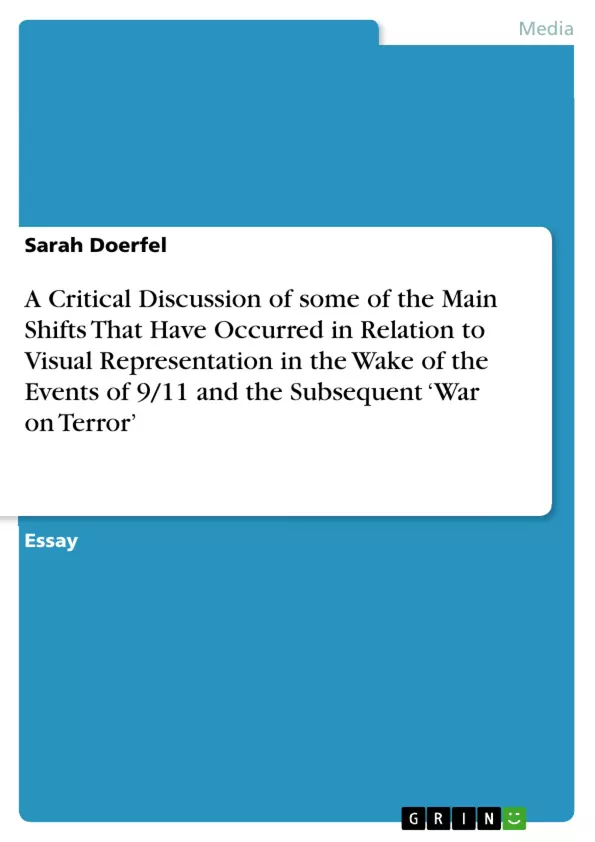The events of 9/11 shocked people all over the world and as a political consequence the ‘war on terror’ was established. A ‘public trauma’ emerged after the unexpected attacks because they made clear how near the unknown but also continuing threat of terrorism is. An extraordinary situation took place when people world wide felt shocked and directly targeted by the attacks.
The exploding demand on visual media which dealt with the issue was the expression of a new function in the wake of the events: Visual representation had to assume the responsibility of substituting for the essential act of ‘bearing witness’ to help the public with handling trauma and grief (Zelizer, 2002).
Fighting a war against an unknown enemy – ‘the terror’ or ‘the evil’ – was a historically unprecedented situation. People were frightened and many wanted to find somebody to blame for the attacks to feel safe again; the reaction of the government to attack Afghanistan found support although the justification for the attacks would be proven wrong later. But the dimension of cruelty of this war and in the American prison Abu Ghraib towards alleged terrorists caused another public shock after the limited imagery was published.
Together, these two events and their subsequent public traumas caused two very contrasting consecutive world wide moods towards the US government.
In retrospect the events are said to mark a change within visual representation, particularly the representation of trauma.
One of the main shifts in visual representation in the wake of these crises was that the focus moved towards the public. ”This was curious, for among photojournalists the idea of using images to draw from and upon the public rather than to depict the events being witnessed was antithetical to what good journalism is supposed to do” (Zelizer, 2002, p.48).
Inhaltsverzeichnis (Table of Contents)
- Introduction
- Visual Representation and the Events of 9/11
- Shifting Focus: From Events to Public Response
- The Power of Repetition: Trauma and Iconic Imagery
- Conclusion
Zielsetzung und Themenschwerpunkte (Objectives and Key Themes)
This paper examines the significant changes in visual representation following the events of 9/11 and the subsequent 'War on Terror.' The study analyzes how these events impacted the ways in which trauma and conflict are depicted, particularly focusing on the shifts from event-centric to public-centric representation, the rise of iconic imagery, and the role of media in shaping public perception.- The impact of 9/11 and the 'War on Terror' on visual representation
- The shift from event-centric to public-centric representation
- The role of iconic imagery in shaping public trauma and memory
- The influence of media on public perception and support for political actions
- The use of visual media in exploring personal experiences of trauma
Zusammenfassung der Kapitel (Chapter Summaries)
This section focuses on summarizing the main themes of the paper, excluding any major conclusions or spoilers. The chapters are presented in a clear and concise manner to provide an overview of the work's content.Introduction
This chapter provides a brief introduction to the topic of visual representation in the context of the 9/11 attacks and the subsequent 'War on Terror.' It highlights the significance of these events in shaping the landscape of visual culture and introduces the key themes to be explored in the subsequent chapters.Visual Representation and the Events of 9/11
This chapter explores the initial impact of the 9/11 attacks on visual representation. It analyzes the role of visual media in capturing and conveying the magnitude of the events, highlighting how the demand for visual content surged in response to the public's need to understand and process the trauma. It discusses the shift from traditional journalistic approaches to a more public-centric focus, where the emphasis shifted from depicting the events to documenting the public's reactions.Shifting Focus: From Events to Public Response
This chapter delves deeper into the changing nature of visual representation in the wake of 9/11. It examines how the focus shifted from documenting the events themselves to capturing the public's emotional responses, highlighting the use of images that emphasized the public's experience of shock, fear, and grief. It analyzes how this shift played a significant role in shaping public perception and support for political actions.The Power of Repetition: Trauma and Iconic Imagery
This chapter explores the phenomenon of iconic imagery in the context of trauma and conflict. It examines how certain images related to the 9/11 attacks and the Abu Ghraib prison became deeply embedded in the public consciousness, becoming symbolic representations of these traumatic events. It analyzes the role of media repetition in shaping the meaning and impact of these images, and the ways in which they served as visual reminders of the lasting effects of these events.Schlüsselwörter (Keywords)
This research paper focuses on the crucial aspects of visual representation in the wake of the events of 9/11 and the subsequent 'War on Terror.' It examines the impact of these events on visual culture, particularly focusing on the themes of trauma, public response, iconic imagery, and media influence. Key terms and concepts include public trauma, visual representation, iconic imagery, media repetition, and the shift from event-centric to public-centric representation.- Quote paper
- Sarah Doerfel (Author), 2010, A Critical Discussion of some of the Main Shifts That Have Occurred in Relation to Visual Representation in the Wake of the Events of 9/11 and the Subsequent ‘War on Terror’, Munich, GRIN Verlag, https://www.grin.com/document/208528



